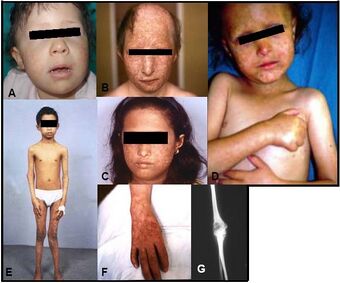Medicine:Rothmund–Thomson syndrome
| Rothmund–Thomson syndrome | |
|---|---|
| Other names | Poikiloderma atrophicans with cataract or Poikiloderma congenitale[1][2] |
 | |
| Panel showing some clinical features of the RTS syndrome. A) Chronic phase of cheek poikiloderma (4-year-old girl). B) Poikiloderma with alopecia (21-year-old boy). C) Poikiloderma. D) Poikiloderma sparing the trunk (courtesy of Professor M. Paradisi, Rome). E) Photo distributed poikiloderma and valgism of the knees. F) Thumb aplasia (patient B). G) Bone defect seen by X-Rays: cystic-like destructive lesion of the humerus (distal epiphysis) without apparent solution of continuity of the cortical bone (patient E). | |
Rothmund–Thomson syndrome (RTS) is a rare autosomal recessive[3][4] skin condition.
There have been several reported cases associated with osteosarcoma. A hereditary basis, mutations in the DNA helicase RECQL4 gene, causing problems during initiation of DNA replication has been implicated in the syndrome.[1][5][6][7]
Signs and symptoms
- Sun-sensitive rash with prominent poikiloderma and telangiectasias
- Juvenile cataracts
- Saddle nose
- Congenital bone defects, including short stature and radial ray anomalies such as absent thumbs
- Hair growth problems (absent eyelashes, eyebrows and/or hair)
- Hypogonadism has not been well documented
- Hypodontia
- Calcium problems (not documented in journals)
- Ear problems (not documented in journals but identified by patients in support groups)
- Produces osteosarcoma[8]
The skin is normal at birth. Between 3 and 6 months of age, the affected carrier develops poikiloderma on the cheeks. This characteristic "rash" that all RTS carriers have can develop on the arms, legs and buttocks. "Poikiloderma consists of areas of increased and decreased pigmentation, prominent blood vessels, and thinning of the skin."[9]
Accelerated aging
In humans, individuals with RTS, and carrying the RECQL4 germline mutation, can have several clinical features of accelerated aging. These features include atrophic skin and pigment changes, alopecia, osteopenia, cataracts and an increased incidence of cancer.[10] Also in mice, RECQL4 mutants show features of accelerated aging.[11]
Causes
RTS is caused by a mutation of the RECQL4 gene, located at chromosome 8q24.3.[5][12] The disorder is inherited in an autosomal recessive manner.[3] This means the defective gene responsible for the disorder is located on an autosome (chromosome 8 is an autosome), and two copies of the defective gene (one inherited from each parent) are required in order to be born with the disorder. The parents of an individual with an autosomal recessive disorder both carry one copy of the defective gene, but usually do not experience any signs or symptoms of the disorder.[citation needed]
DNA repair
RECQL4 has a crucial role in DNA end resection that is the initial step required for homologous recombination (HR)-dependent double-strand break repair.[13] When RECQL4 is depleted, HR-mediated repair and 5’ end resection are severely reduced in vivo. RECQL4 also appears to be necessary for other forms of DNA repair including non-homologous end joining, nucleotide excision repair and base excision repair.[10] The association of deficient RECQL4-mediated DNA repair with accelerated aging is consistent with the DNA damage theory of aging.[citation needed]
Diagnosis
Management
History
The condition was originally described by August von Rothmund (1830–1906) in 1868.[14] Matthew Sydney Thomson (1894–1969) published further descriptions in 1936.[15]
See also
- Poikiloderma vasculare atrophicans
- List of cutaneous conditions
- List of radiographic findings associated with cutaneous conditions
References
- ↑ 1.0 1.1 Online Mendelian Inheritance in Man (OMIM) 268400
- ↑ James, William; Berger, Timothy; Elston, Dirk (2005). Andrews' Diseases of the Skin: Clinical Dermatology (10th ed.). Saunders. p. 576. ISBN 978-0-7216-2921-6.
- ↑ 3.0 3.1 Larizza, L.; Roversi, G.; Volpi, L. (Jan 2010). "Rothmund-Thomson syndrome". Orphanet Journal of Rare Diseases 5: 2. doi:10.1186/1750-1172-5-2. PMID 20113479.
- ↑ "Rothmund-Thomson syndrome: more than just a cosmetic concern". J Coll Physicians Surg Pak. 17 (7): 423–424. 2007. PMID 17686357.
- ↑ 5.0 5.1 "Rothmund–Thomson syndrome and RECQL4 defect: Splitting and lumping". Cancer Letters 232 (1): 107–120. January 2006. doi:10.1016/j.canlet.2005.07.042. PMID 16271439.
- ↑ "Clinicopathologic features of osteosarcoma in patients with Rothmund-Thomson syndrome". J. Clin. Oncol. 25 (4): 370–5. 2007. doi:10.1200/JCO.2006.08.4558. PMID 17264332.
- ↑ "Initiation of DNA replication requires the RECQL4 protein mutated in Rothmund-Thomson syndrome". Cell 121 (6): 887–98. Jun 2005. doi:10.1016/j.cell.2005.05.015. PMID 15960976.
- ↑ "Clinical manifestations in a cohort of 41 Rothmund-Thomson syndrome patients". Am. J. Med. Genet. 102 (1): 11–17. 2001. doi:10.1002/1096-8628(20010722)102:1<11::AID-AJMG1413>3.0.CO;2-A. PMID 11471165.
- ↑ Understanding RTS pamphlet, RTS Team: Lisa L. Wang (Oncologist), Moise L. Levy (dermatologist), Richard A. Lewis (Ophthalmologist), Sharon E. Plon (Geneticist)
- ↑ 10.0 10.1 "Aging in Rothmund-Thomson syndrome and related RECQL4 genetic disorders". Ageing Res. Rev. 33: 30–35. 2017. doi:10.1016/j.arr.2016.06.002. PMID 27287744.
- ↑ "Senescence induced by RECQL4 dysfunction contributes to Rothmund-Thomson syndrome features in mice". Cell Death Dis 5 (5): e1226. 2014. doi:10.1038/cddis.2014.168. PMID 24832598.
- ↑ Online Mendelian Inheritance in Man (OMIM) 603780
- ↑ "RECQL4 Promotes DNA End Resection in Repair of DNA Double-Strand Breaks". Cell Rep 16 (1): 161–73. 2016. doi:10.1016/j.celrep.2016.05.079. PMID 27320928.
- ↑ Lu, Linchao; Jin, Weidong; Wang, Lisa L. (2016). "Aging in Rothmund-Thomson syndrome and related RECQL4 genetic disorders". Ageing Research Reviews 33: 30–35. doi:10.1016/j.arr.2016.06.002. ISSN 1568-1637. PMID 27287744.
- ↑ Thomson, MS. (Mar 1936). "Poikiloderma Congenitale: Two Cases for Diagnosis.". Proc R Soc Med 29 (5): 453–5. PMID 19990626.
External links
- GeneReviews/NCBI/NIH/UW entry on Rothmund-Thomson Syndrome
- Poikiloderma of Rothmund-Thomson at NIH's Office of Rare Diseases
| Classification | |
|---|---|
| External resources |
 |


